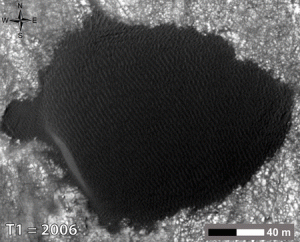Curiosity, NASA’s Mars Science Laboratory rover, is exploring the floor of Gale Crater. Its main science target, however, is the giant stack of water-altered sediments that make up Mount Sharp, Gale Crater’s central mound. But to reach the mound, the rover needs to drive through a field of dark dunes that marches in a line for 35 kilometers (22 miles) along the foot of Mt. Sharp.

ON THE MOVE. Ripples slither across a dune in Gale Crater, as seen in 2006, 2008, and 2011. Click the image to enlarge and animate. (NASA/JPL-Caltech/University of Arizona)
Simone Silvestro (SETI Institute) led a group of researchers who report on the dune field in Geology. Using overlapping images from the HiRISE camera, the scientists traced movements of both ripples on the dunes’ surface and of the dunes themselves over a five-year period (2006 to 2011).
The dunes are basaltic sand and lie about 150 to 200 meters (500 to 650 feet) apart. Dune crests can stretch for 2 km (1.2 mi) and rise about 10 meters (33 ft).
The scientists saw evidence of winds from two directions. While some come from the northwest, the strongest blow from the east-northeast, pushing sand ripples southwest. (This is agrees with a model for Mars atmospheric circulation.) The team suggests this wind comes from regional winds interacting with Mt. Sharp.
The average distance that sand dunes moved was 2 meters (7 feet) over the five Earth years, although some individual dunes moved 3 to 4 meters (10 to 13 ft) in that time. This doesn’t sound like much, yet Curiosity’s mission control team will pay close attention in making driving plans.
In any case, the researchers note, “Roving between the dunes represents a unique opportunity to validate the accuracy of wind predictions and to make the first ground observations of a known active environment on Mars.”








